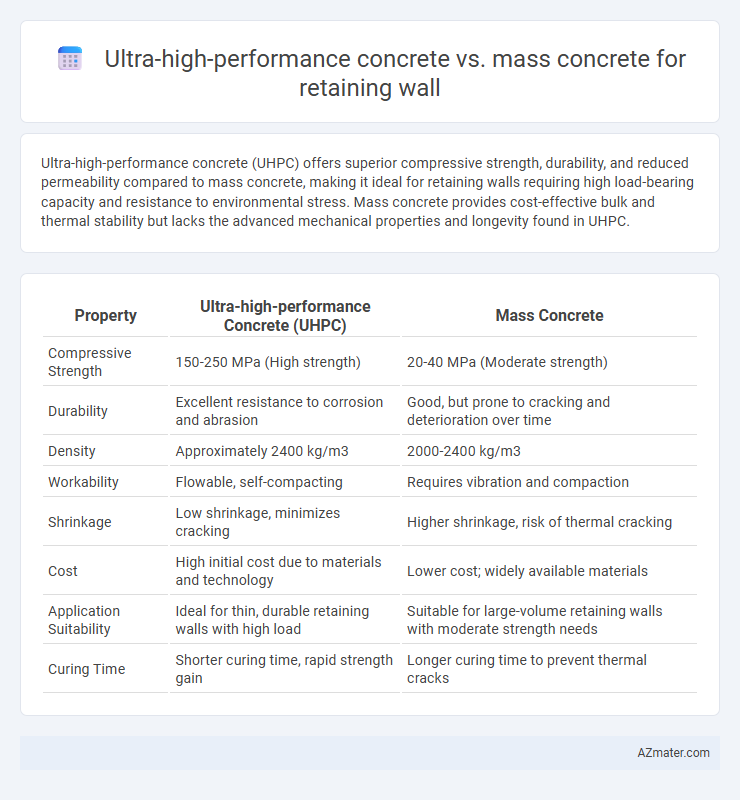Ultra-high-performance concrete (UHPC) offers superior compressive strength, durability, and reduced permeability compared to mass concrete, making it ideal for retaining walls requiring high load-bearing capacity and resistance to environmental stress. Mass concrete provides cost-effective bulk and thermal stability but lacks the advanced mechanical properties and longevity found in UHPC.
Table of Comparison
| Property | Ultra-high-performance Concrete (UHPC) | Mass Concrete |
|---|---|---|
| Compressive Strength | 150-250 MPa (High strength) | 20-40 MPa (Moderate strength) |
| Durability | Excellent resistance to corrosion and abrasion | Good, but prone to cracking and deterioration over time |
| Density | Approximately 2400 kg/m3 | 2000-2400 kg/m3 |
| Workability | Flowable, self-compacting | Requires vibration and compaction |
| Shrinkage | Low shrinkage, minimizes cracking | Higher shrinkage, risk of thermal cracking |
| Cost | High initial cost due to materials and technology | Lower cost; widely available materials |
| Application Suitability | Ideal for thin, durable retaining walls with high load | Suitable for large-volume retaining walls with moderate strength needs |
| Curing Time | Shorter curing time, rapid strength gain | Longer curing time to prevent thermal cracks |
Introduction to Retaining Walls
Retaining walls are essential structures designed to hold back soil and prevent erosion or landslides, commonly used in landscaping, road construction, and infrastructure projects. Ultra-high-performance concrete (UHPC) provides superior strength, durability, and reduced permeability compared to mass concrete, making it ideal for retaining walls requiring slender profiles and extended lifespan. Mass concrete, characterized by its larger volume and conventional strength, remains widely used for retaining walls in applications where cost efficiency and straightforward construction are prioritized.
Overview of Ultra-High-Performance Concrete (UHPC)
Ultra-High-Performance Concrete (UHPC) is a composite material known for its exceptional strength, durability, and high compressive strength exceeding 150 MPa, making it ideal for retaining wall applications requiring slim profiles and enhanced load resistance. Its dense microstructure, achieved through fine powders and fiber reinforcement, provides superior resistance to environmental degradation, reducing maintenance and extending service life compared to traditional mass concrete. UHPC also offers improved ductility and tighter crack control, critical for retaining walls subjected to high lateral earth pressures and dynamic forces.
Characteristics of Mass Concrete
Mass concrete for retaining walls is characterized by its large volume and low heat generation during curing, which minimizes thermal cracking risks. It typically has lower strength and durability compared to ultra-high-performance concrete but offers excellent stability and cost-effectiveness for large-scale structures. The use of mass concrete requires careful mix design and temperature control to ensure structural integrity over time.
Strength Comparison: UHPC vs Mass Concrete
Ultra-high-performance concrete (UHPC) exhibits compressive strengths exceeding 150 MPa, significantly outperforming mass concrete, which typically ranges between 20 to 40 MPa. The superior microstructure and fiber reinforcement in UHPC contribute to enhanced tensile strength and durability, making it ideal for thin, high-strength retaining walls. Mass concrete requires greater cross-sectional dimensions to achieve structural integrity, whereas UHPC allows for slender, more efficient designs with reduced material volume.
Durability and Longevity
Ultra-high-performance concrete (UHPC) offers superior durability and longevity compared to mass concrete in retaining wall applications due to its dense microstructure and high compressive strength exceeding 150 MPa. UHPC exhibits exceptional resistance to chloride ingress, freeze-thaw cycles, and chemical attack, significantly reducing maintenance costs and extending service life beyond 100 years. Mass concrete, while cost-effective for large structures, is more susceptible to cracking and degradation over time, limiting its durability under aggressive environmental conditions.
Construction Techniques and Challenges
Ultra-high-performance concrete (UHPC) offers superior strength and durability compared to mass concrete, enabling thinner retaining wall designs with longer spans and reduced reinforcement requirements. Construction techniques for UHPC require precise mixing, specialized curing methods, and careful placement to avoid segregation and ensure full compaction, whereas mass concrete demands rigorous temperature control to prevent thermal cracking and often requires large-scale formwork and extended curing times. Challenges with UHPC include higher material costs and the need for skilled labor, while mass concrete poses difficulties in managing heat generation and shrinkage in massive pours.
Cost Analysis and Economic Considerations
Ultra-high-performance concrete (UHPC) offers superior strength and durability for retaining walls but entails higher material and production costs compared to mass concrete. While mass concrete provides a cost-effective solution with lower initial investment, UHPC reduces long-term maintenance and repair expenses due to its enhanced lifespan and resistance to environmental stressors. Economic considerations must balance upfront expenditure against lifecycle savings, making UHPC advantageous for projects prioritizing longevity and reduced maintenance budgets.
Environmental Impact and Sustainability
Ultra-high-performance concrete (UHPC) significantly reduces environmental impact compared to mass concrete for retaining walls due to its lower cement content and higher durability, resulting in less carbon footprint and extended service life. UHPC's dense microstructure minimizes permeability and deterioration, reducing maintenance needs and conserving resources over time. Mass concrete, while often less expensive initially, demands higher material volume and energy for curing, leading to greater CO2 emissions and increased resource consumption.
Design Flexibility and Architectural Possibilities
Ultra-high-performance concrete (UHPC) offers superior design flexibility for retaining walls due to its exceptional strength and durability, enabling thinner, more intricate shapes and longer spans compared to mass concrete. UHPC's high compressive strength and enhanced tensile properties allow for innovative architectural possibilities such as slender profiles, complex textures, and integrated reinforcement, which mass concrete cannot achieve effectively. Mass concrete, while robust, often requires larger cross-sections and extensive formwork, limiting design creativity and imposing constraints on aesthetic variation in retaining wall construction.
Conclusion: Selecting the Optimal Concrete for Retaining Walls
Ultra-high-performance concrete (UHPC) offers superior strength, durability, and reduced permeability compared to mass concrete, making it an ideal choice for retaining walls subjected to high loads and aggressive environments. Mass concrete, while cost-effective and suitable for large-scale projects, often requires more volume and prolonged curing times to achieve comparable performance. Selecting UHPC enhances longevity and structural integrity, justifying its higher initial investment for critical retaining wall applications.

Infographic: Ultra-high-performance concrete vs Mass concrete for Retaining wall
 azmater.com
azmater.com